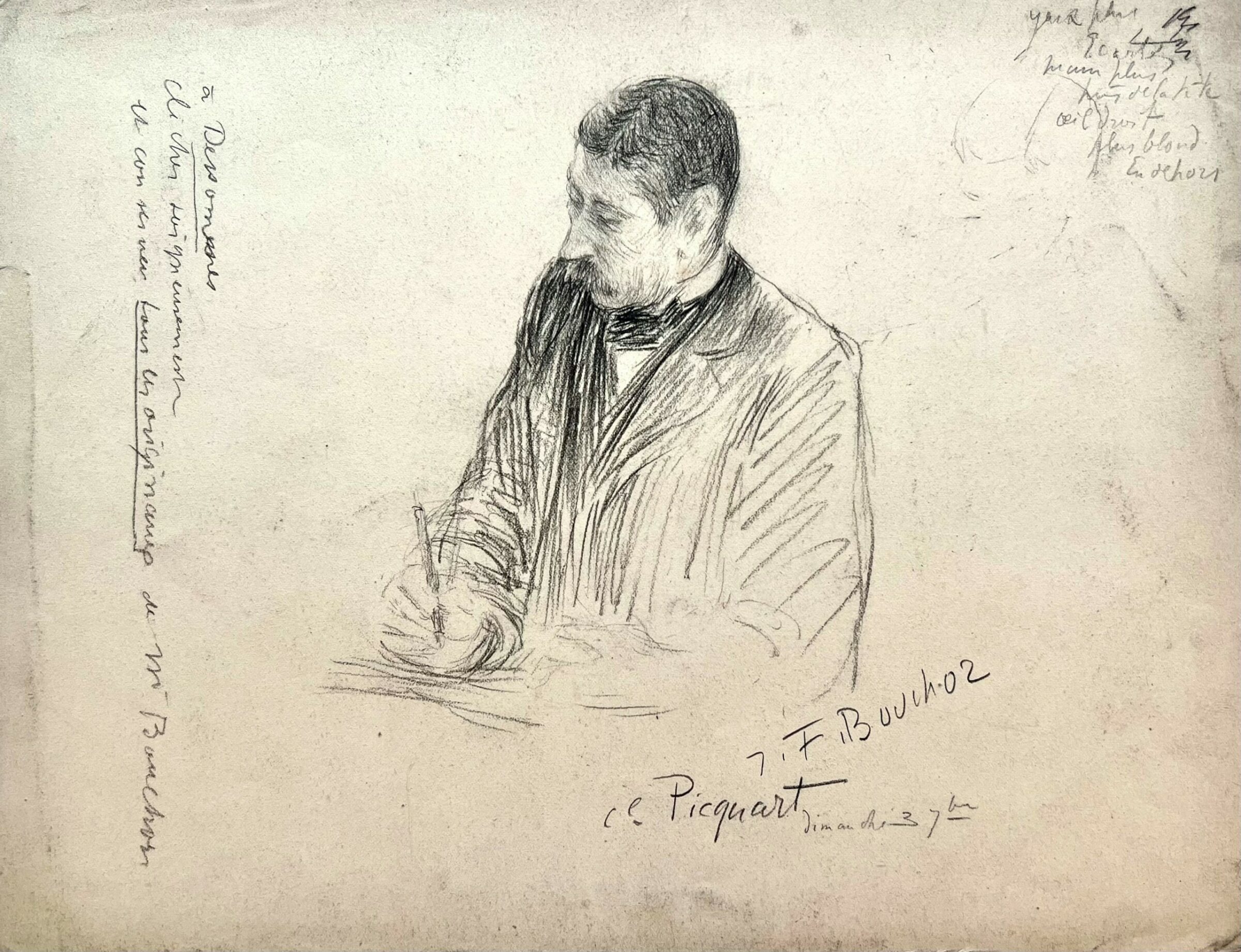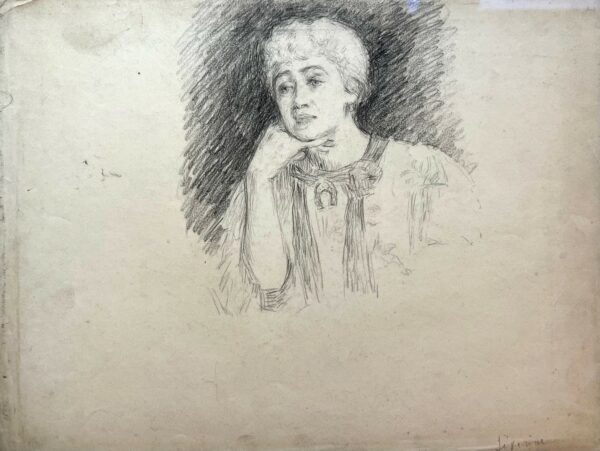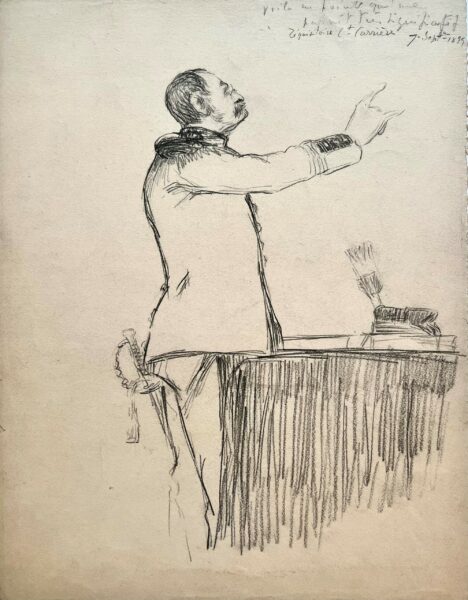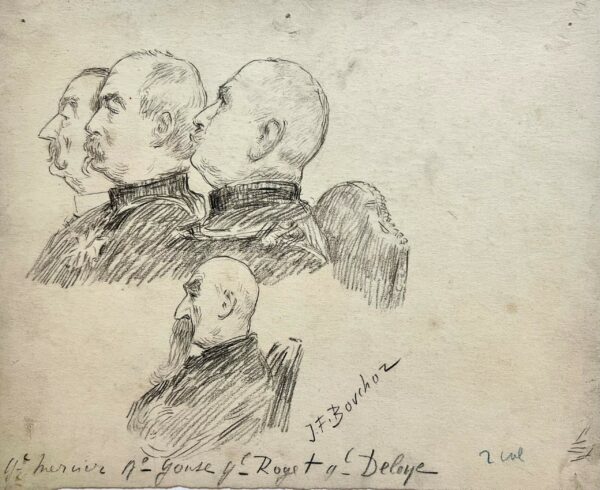[DREYFUS, AFFAIR.] BOUCHOR, JOSEPH-FÉLIX. (1853-1937). French portrait artist. Signed Drawing. (“J. F. Bouchor”). 1p. Large 4to. (9¾” x 12½”). [Rennes], September 3, 1899. Bouchor’s eye-witness courtroom pencil sketch depicting Georges-Marie Picquart (1854-1914), French officer, Dreyfus’ instructor at the War College and chief of military intelligence. In 1896, following the interception of a letter (the petit bleu) from the German military attaché in Paris to French Major Ferdinand Walsin Esterhazy, Picquart opened an investigation into Esterhazy, the spy whose treason had been pinned on Dreyfus. The drawing depicts Picquart taking notes and is inscribed vertically in the left margin in an unknown hand, “to Dessommes / Carefully make a cliché and keep all of Mr. Bouchoz’s originals” (à Dessommes / Clicher soigneusement et conserver tous les originaux de M. Bouchoz).
The 1894 conviction for treason of French-Jewish artillery captain Alfred Dreyfus and his subsequent exile and imprisonment on the French Guiana penal colony Devil’s Island, hinged on an intercepted memo, or bordereau, which revealed French military secrets and had been sent anonymously to the German military attaché, Captain Schwartzkoppen, in Paris. The memo’s actual author was French Major Marie-Charles-Ferdinand Walsin-Esterhazy, a spy in German employ. Additional evidence, intended to implicate Dreyfus, was secretly forged by French Army officers and submitted to the military judges presiding over the legal proceedings. Following his conviction, Dreyfus languished for years in solitary confinement, while his family and supporters attempted to clear his name. Anti-Dreyfusards, led by a virulent anti-Semitic French press, regularly circulated rumors and lies about him.
Despite his own anti-Semitism, Picquart, in 1896, reported the discovery of the petit bleu which implicated Esterhazy and exonerated Dreyfus. Engaged in a massive cover-up, the army first punished Picquart by re-assigning him to active duty in Tunisia. Then, upon Esterhazy’s acquittal on January 11, 1898, Picquart was imprisoned the day Zola’s letter J’Accuse…! was published. Picquart testified at Zola’s libel trial and became one of Dreyfus’ most outspoken supporters. On February 1, 1898, Picquart was “discharged for gross misconduct in the service,” effective February 26th, three days after Zola was found guilty. Picquart was then falsely charged of forging the petit bleu, which led to his second imprisonment on July 13, 1898, five days before Zola’s second conviction. Petitions, signed by thousands calling for Picquart’s release were circulated in Le Siècle and L’Aurore before he was freed on June 13, 1899, ten days before he penned our letter. In 1906, like Dreyfus, Picquart was exonerated and promoted brigadier general; on October 25th he became Clemenceau’s Minister of War. Picquart is the protagonist in Robert Harris’ best-selling 2013 historical thriller An Officer and a Spy.
The truth of Dreyfus’ innocence finally emerged in the summer of 1898 after Henry confessed to his forgeries, committed suicide, and Esterhazy fled to England. General Boisdeffre, the army’s Chief of the General Staff who had been convinced of Dreyfus’ guilt from the beginning, resigned after Henry’s confession. Considering these events, the court annulled the 1894 judgment against Dreyfus and granted him a second military trial in Rennes. Dreyfus, frail and in poor health, sailed from his island exile on June 9, 1899, to appear at the Rennes trial on August 7th.
Journalists and artists from around the world swarmed Rennes to observe the trial that would be “a culminating point of l’affaire. It was the last opportunity for the military system of justice to redeem itself… The first military tribunal [in 1894] had been able to insist that no hearings be conducted publicly. At Rennes, the second military tribunal held all hearings publicly, except for one, and the fact that the court insisted on holding any at all behind closed doors both exacerbated criticism of the proceedings and was hotly contested by the defense, for this time the eyes of the country and of the world were fixed on Rennes. The world press was ready to convict France if France convicted Dreyfus. And France itself, author of the Rights of Man and Citizens, country of the philosophes, and of the Enlightenment, was only too painfully aware of this,” (“The Military Trial at Rennes: Text and Subtext of the Dreyfus Affair,” Touro Law Review, Curran). The trial was covered in detail by newspapers and magazines worldwide and was even dramatized in Georges Méliès series of short silent films, produced concurrently with the trial becoming the first ever film serial! (Nine of the eleven films can be viewed here: https://www.youtube.com/watch?v=Y3Re6Y1G8_U).
“By the time the Rennes trial took place, proof of his innocence abounded,” (The Affair: The Case of Alfred Dreyfus, Bredin). Dreyfus was defended at court by Edgar Demange, who had been engaged by his family in 1894, and by prominent criminal attorney Ferdinand Labori, who had defended Emile Zola after his famous publication of J’Accuse…! One week into the trial, on August 14, while walking to court with Picquart, Labori was shot in the back by a would-be assassin. Though badly wounded, Labori returned to court on August 22.
Picquart’s testimony took place over the course of two days. On August 17th, “Picquart, in civilian clothes, begins his deposition. He recounts the role he has played in the Affair since 1894 and reveals the faults of the Ministry of War. He blames Du Paty [du Clam] for many of these. Picquart recalls the deep impression caused by Henry’s testimony at the court martial of Dreyfus (1894) and analyses the bordereau in situ to prove that Dreyfus could not have written it… [On August 18th] Picquart continues his deposition, which lasts almost five hours. In a meticulous analysis of the Secret Dossier of 1894, he proves that none of its four documents can be related to Dreyfus. He describes his discovery of the petit bleu and the subsequent maneuvers against him,” (The Dreyfus Affair, A Chronological History, Whyte). On September 9, the judges, by a majority of five to two, found Dreyfus guilty of treason under the absurd concept of “extenuating circumstances,” and sentenced him to ten years detention. Ten days later President Émile Loubet issued Dreyfus a pardon. Dreyfus, initially opposed to accepting any pardon as it would have compelled him to withdraw his petition for a legal revision and acknowledge responsibility for a crime he steadfastly maintained he never committed, finally acquiesced, providing he could still try to clear his name.
Despite the ongoing vitriolic attacks in the press and public displays by anti-Dreyfus elements, the Court of Cassation finally declared Dreyfus innocent 1906. The Dreyfus Affair’s significance is so far-reaching that the human rights movement, the origins of modern-day Zionism (Theodor Herzl was in Paris covering Dreyfus’ first trial for his Viennese newspaper), and the French separation of church and state can all claim to have been born during this dark chapter in French history.
Educated at the Beaux-Arts and an exhibitor at the Salon des Artistes Francis, Bouchor became known for his portraits of General John Pershing and French President Georges Clemenceau (a supporter of Dreyfus and publisher of Zola’s “J’Accuse…!”) as well as his illustrations of the American Expeditionary Forces in World War I and Orientalist paintings inspired by his travels in North Africa.
Provenance: Isabelle Lazar (nee Grumbacher), wife of Jewish journalist Bernard Lazare, anarchist, literary critic and one of Dreyfus’ earliest and most vocal defenders who covered the Rennes trial for The Chicago Record and The North American Review.
In very fine condition.





